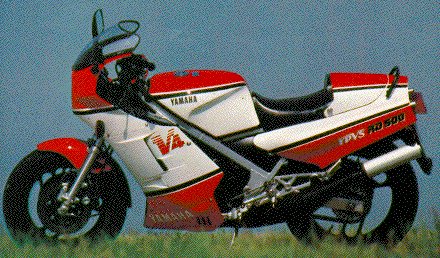
(54Ko jpg)

 (#643 & #656)
(#643 & #656) Inspired by the YZR500 factory
racer ridden by
Roberts (14Ko jpg)
during the 1983 Grand Prix season, the RD500 was the closest thing to a
Grand Prix bike. And in 1984, you could get your hands on the twin-crank
V4 bike. Three different versions of the red & white bike were available
worldwide.
Inspired by the YZR500 factory
racer ridden by
Roberts (14Ko jpg)
during the 1983 Grand Prix season, the RD500 was the closest thing to a
Grand Prix bike. And in 1984, you could get your hands on the twin-crank
V4 bike. Three different versions of the red & white bike were available
worldwide.

 The RD500LC, which comes equipped with Michelin tires, was sold in France
and in Europe. In Australia, New Zealand and Canada, the bike was sold
named RZ500 (39Ko jpg) and had
the same equipment than in European version. Japan received a limited edition
RZV500R, replete with a lighter aluminium frame (the others used
steel) and other goodies. But the engine power was tuned down to 64 Hp.
The RD500LC, which comes equipped with Michelin tires, was sold in France
and in Europe. In Australia, New Zealand and Canada, the bike was sold
named RZ500 (39Ko jpg) and had
the same equipment than in European version. Japan received a limited edition
RZV500R, replete with a lighter aluminium frame (the others used
steel) and other goodies. But the engine power was tuned down to 64 Hp.
The RD500 or RZ500 were never sold legaly
in the United States due to Environmental Protection Agency. Does a RD500
pollute!!!!
 The frame is a mild steel
box-section rails in a perimeter layout. The rear shock, which on most
bikes is in an upright position under the seat, had to be placed horizontally
under the engine. The under-seat area is packed full of the upper cylinders'
exhaust cambers, the battery and the YPVS servo motor. This positioning
adds the benefit of consolidating mass in order to improve the RD's center
of gravity and to make the bike flickable. The rear of the shock connects
to an extruded aluminum swingarm via a forged-aluminum rocker; a small
forged link attached to the rocker's center pivot positions it relative
to the frame. A few other chassis features incorporated on the 500 were
innovative . For
instance, the bike's non-adjustable forks use spindly 37mm stanchion tubes,
and the front of each lower fork leg carries an adjustable anti-dive valve.
The twin disc brakes up front, as well as the rear disc, are ventilated,
an experiment Yamaha tried on several of it's street bikes in the mid Eighties
(FJ1100...).
The frame is a mild steel
box-section rails in a perimeter layout. The rear shock, which on most
bikes is in an upright position under the seat, had to be placed horizontally
under the engine. The under-seat area is packed full of the upper cylinders'
exhaust cambers, the battery and the YPVS servo motor. This positioning
adds the benefit of consolidating mass in order to improve the RD's center
of gravity and to make the bike flickable. The rear of the shock connects
to an extruded aluminum swingarm via a forged-aluminum rocker; a small
forged link attached to the rocker's center pivot positions it relative
to the frame. A few other chassis features incorporated on the 500 were
innovative . For
instance, the bike's non-adjustable forks use spindly 37mm stanchion tubes,
and the front of each lower fork leg carries an adjustable anti-dive valve.
The twin disc brakes up front, as well as the rear disc, are ventilated,
an experiment Yamaha tried on several of it's street bikes in the mid Eighties
(FJ1100...).

 The 1983 OW -70 bike used a 50-degree, twin-crank V-four motor equipped
with Yamaha' YPVS exhaust power valves. The RD utilized reed valves to
achieve a broader, more street-oriented power band. But, again due to limited
space in the V, the reed valves used two different intake arrangements.
The lower cylinders were fed through crankcase reeds; the upper pair used
cylinder reeds (34Ko jpg), with
90 degree intake manifolds connecting each reed block to it's side-mounted
carburetor.
The 1983 OW -70 bike used a 50-degree, twin-crank V-four motor equipped
with Yamaha' YPVS exhaust power valves. The RD utilized reed valves to
achieve a broader, more street-oriented power band. But, again due to limited
space in the V, the reed valves used two different intake arrangements.
The lower cylinders were fed through crankcase reeds; the upper pair used
cylinder reeds (34Ko jpg), with
90 degree intake manifolds connecting each reed block to it's side-mounted
carburetor.
 The dual primary drives were
geared directly to the clutch, while the front crankshaft also spun a counter
balancer that is mounted deep inside the "V" between the two cranks. The
counter balancer, unusual on a two-stroke, helped dampen engine vibration.
A servo-controlled YPVS system -similar to the system used on Yamaha's
RD350 - bolstered low and mid-range power, and let gasses flow into four
individual expansion chambers.
The dual primary drives were
geared directly to the clutch, while the front crankshaft also spun a counter
balancer that is mounted deep inside the "V" between the two cranks. The
counter balancer, unusual on a two-stroke, helped dampen engine vibration.
A servo-controlled YPVS system -similar to the system used on Yamaha's
RD350 - bolstered low and mid-range power, and let gasses flow into four
individual expansion chambers.

Manufacturer: Yamaha Model: RD500LC Price: 42000 in 1984 Engine: Two-stroke, liquid-cooled, reed-valved 50-degree V4 Bore x stroke: 56.4 x 50.0 mm Displacement: 499cc Carburetion: (4) 26mm Mikuni Transmission: 6-speed Wheelbase: 1375 mm Seat height: 780 mm Fuel capacity: 22 l Claimed dry weight: 177 Kg